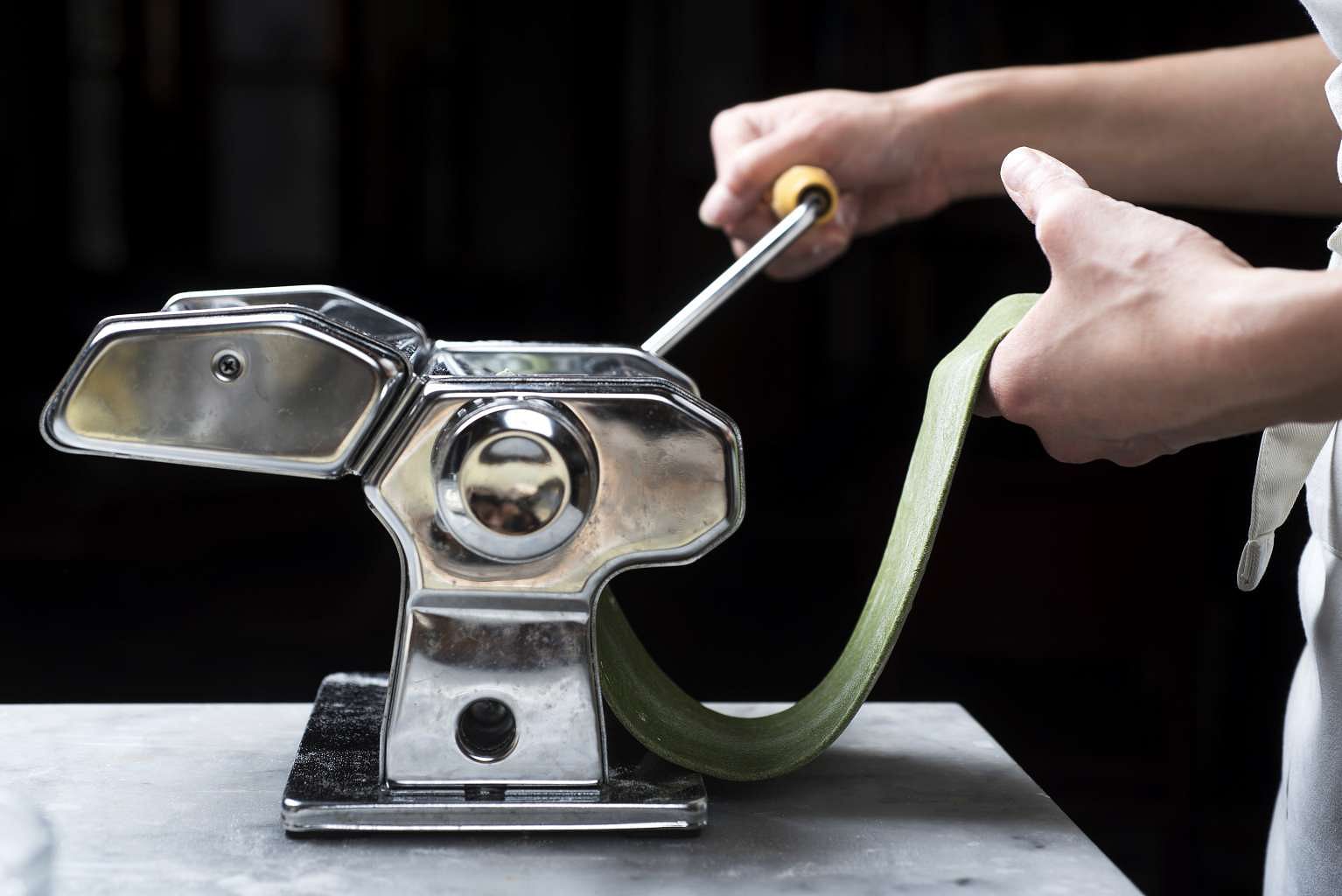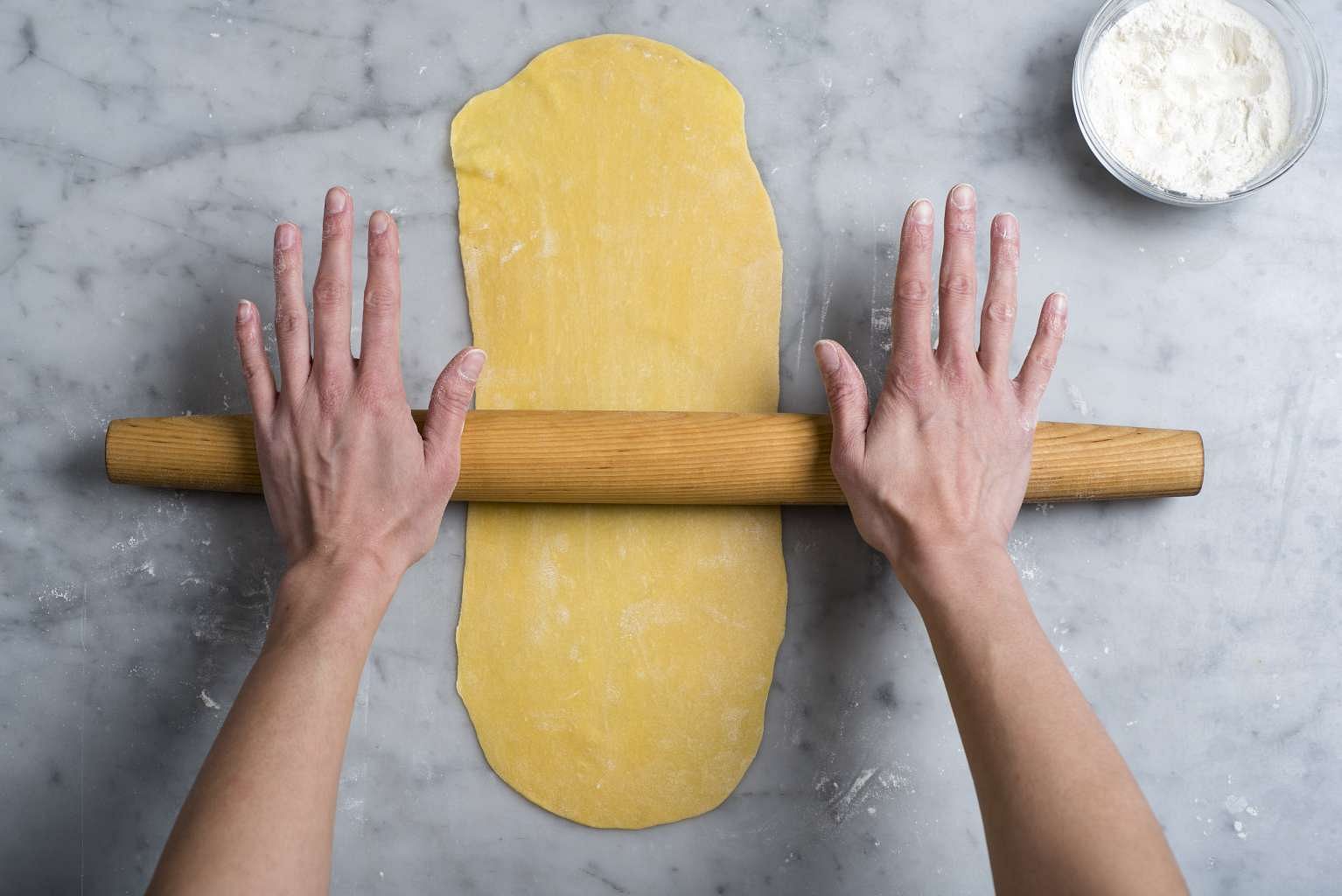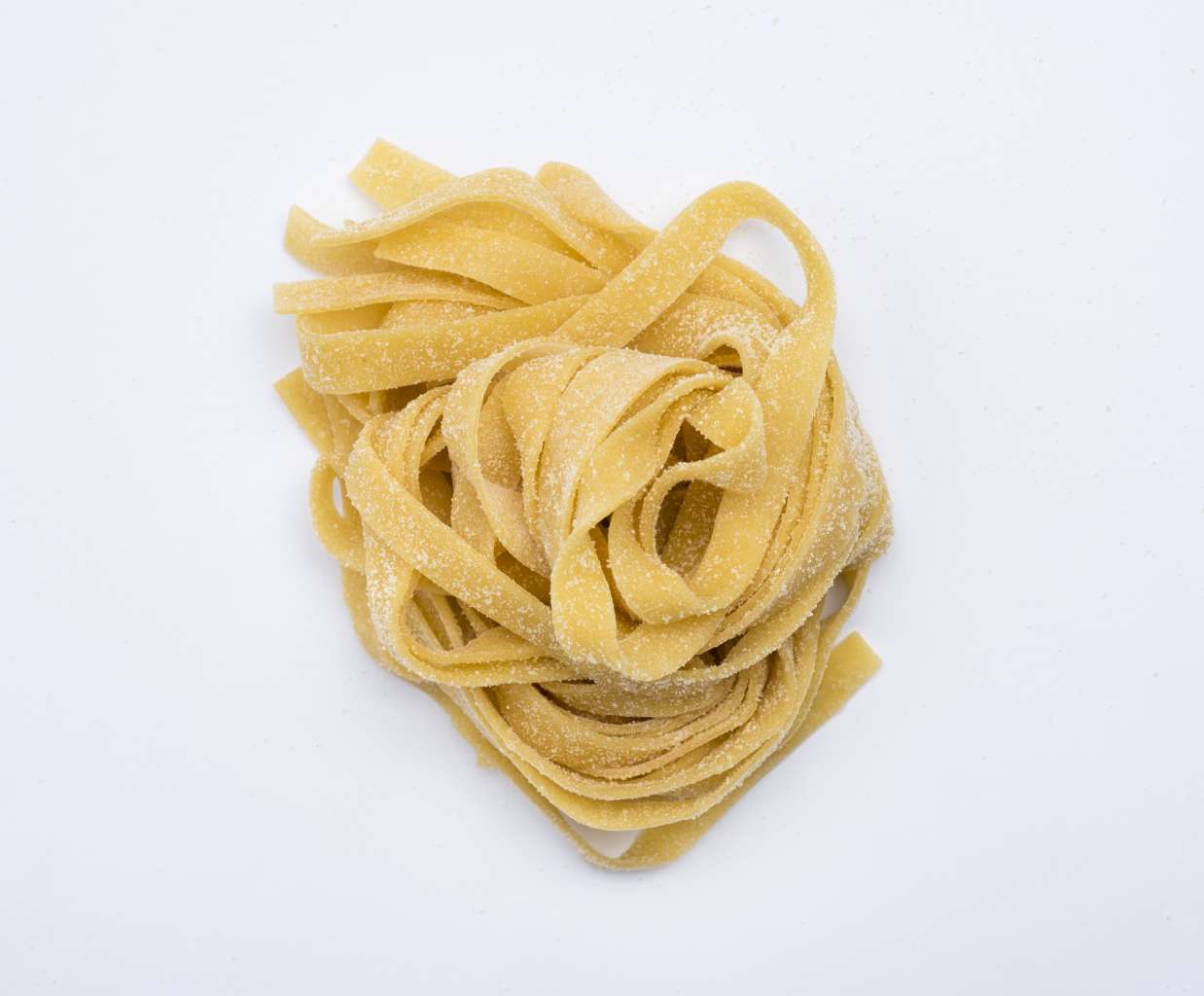A step-by-step guide to making your own pasta, and two recipe variations
Sign up now: Weekly recommendations for the best eats in town
Samin Nosrat
Follow topic:
(NYTIMES) - Making pasta from scratch is the ultimate exercise in instinctual cooking. With time and a little effort, a dough made of just flour and eggs can take on many different forms. Here, Samin Nosrat walks you through the basics of making dough, then rolling and cutting it into savory noodles.
Our complete guide, with video instruction and more recipes, is at nytcooking.com.
Rolling the dough
The pasta-making process can be time consuming at first, so save it for a weekend. A pasta roller is a huge asset; it's worth buying one. Think of rolling by hand as an advanced technique: Once you've developed a sense for working with the dough, you will have a much better understanding of how it will respond.
Using a Pasta Machine

A pasta rolling machine is used to make a sheet of spinach pasta -- the device also has a cutting attachment for creating the noodles. PHOTO: NYTIMES
Most recipes, including ours, give instructions for using a pasta roller. There's a good reason for that: It's more difficult to roll dough by hand. Even an inexpensive hand-cranked machine will save you time and frustration.
When you're working with pasta, you'll also need all of your senses. You'll quickly learn that every batch is different, depending on everything from humidity and weather to the type of flour and size of your eggs. If pasta threatens to stick, dust both the pasta and the work surface with flour. If it's too dry, add another yolk.
And finally, though it can be hypnotising, resist the urge to watch the pasta as it comes out of the rollers. Instead, watch as it enters the machine, using one hand to ensure it goes in straight and doesn't ripple or overlap onto itself.
Rolling by Hand

After folding rolled pasta dough into several layers, a knife is used to cut 1.25cm-wide noodles from basic pasta dough. PHOTO: NYTIMES
If we can't persuade you to use a pasta machine, you can always roll by hand.
Before you begin, line three baking sheets with parchment paper and lightly dust with semolina flour. Set aside. Cut off 1/4 of the dough. Rewrap the remaining dough and set aside. Place the portioned-off dough onto a large lightly floured surface. Pushing out from the centre with the heel of your hand, flatten the dough into a circle. Next, use a long rolling pin to push the dough out from the center, without going all the way over the edge. Continue rolling outward, moving the dough a quarter-turn after each roll to preserve the circle. If the dough starts to stick, lightly dust it with flour and work quickly to prevent it from drying out.
When the dough is smooth and round, lay the rolling pin across the top of the circle from 11 o'clock to 1 o'clock. Wrap the shorter end around the pin and roll it a single turn toward yourself to create a tube. Rocking the pin back and forth, use your hands to pull the two edges of the dough away from each other, stretching the sheet until it's about the length of the rolling pin. Unravel the sheet, move it a quarter-turn and repeat the whole process until you've gone around the circle. If necessary, repeat until the entire sheet is translucent, about 0.15cm thick.
Cut the pasta into sheets, and dust lightly with semolina flour. Stack pasta onto the prepared baking sheets and cover with a clean, lightly dampened kitchen towel. Repeat with remaining dough.
Cutting Noodles
Basic pasta sheets present many possibilities. You could use them in a savoury lasagna or fill and shape them into ravioli or tortellini. But for bold results with minimal effort, cut your sheets into noodles.
To cut noodles with a pasta roller, run the pasta sheets, one at a time, through the cutting attachment, then toss with semolina flour. Fluff and separate noodles and pile into nests of single portions (about 85g). Place on parchment-lined baking sheets dusted with semolina flour and cover until ready to use.
To cut noodles by hand, stack four sheets of pasta lightly dusted with semolina flour, then loosely roll into thirds lengthwise (like folding a letter). Cut with a sharp knife (in 1.25cm increments for tagliatelle or fettuccine and 2cm for pappardelle), until all the dough is used. Fluff and separate noodles and pile onto parchment-lined baking sheets into 85g nests. Cover until ready to use.
Cooking and Storing

Form pasta into 85g nests and dust with semolina before cooking. PHOTO: NYTIMES
Unlike dry pasta, fresh pasta must be just-barely cooked through.
At first, the only way to know when the pasta is done is to taste it repeatedly, so stand by the pot, tongs in hand, and be vigilant.
To cook pasta, bring heavily salted water to a rolling boil. For four servings, you'll want to use at least 4.7l of water seasoned with 1/2 cup kosher salt or 6 tablespoons fine sea salt. Don't worry about how much salt it takes: Most will go down the drain. You just need a salty cooking environment to season the pasta.
Add the pasta. After about a minute, stir noodles with tongs or a wooden spoon to encourage them to separate. Pasta cooking water, full of salt and starch, is a gift. It seasons and thickens sauces and helps them cling to the pasta. Sneak out a cup or two before draining the pasta.
Fresh pasta cooks quickly, often in three or four minutes. Cooked pasta should always be tossed with warm sauce - pesto, which is raw, is an exception - to ensure it is coated properly, so have your sauce warm and ready.
To refrigerate, store your pasta in a single layer on a parchment-lined baking sheet. Cover with plastic wrap to keep it from drying out. Refrigerate for up to one night.
To freeze, divide noodles into roughly 85g nests. Store in a single layer on a parchment-lined baking sheet. Freeze until rock hard and transfer to a freezer bag. To cook, drop frozen pasta into salted boiling water and cook for four to seven minutes.
Basic Fresh Pasta Dough
Time: About 45 minutes, plus 30 minutes' resting
Yield: 4 to 6 servings
2 cups (256 grams) 00 or all-purpose flour
2 large eggs
3 egg yolks, plus more as needed
Semolina flour, for dusting
1. Mound flour in the middle of a large, wide mixing bowl. Dig a well in the center of the mound and add eggs and yolks. Using a fork, beat the eggs and incorporate the flour, starting with the well's inner rim. The dough will start coming together in a shaggy mass.
2. Continue to mix dough using your fingers, pressing in any loose bits. If needed, add another egg yolk or a tablespoon of water to absorb all the flour. Once dough comes together, remove it from the bowl.
3. Transfer to a lightly floured surface and knead by hand for four to five more minutes until dough is smooth, elastic and uniform in color. Wrap it in plastic and set aside for at least 30 minutes (and up to four hours) at room temperature. Line three baking sheets with parchment paper and lightly dust with semolina flour. Set aside.
4. Cut off 1/4 of the dough. Rewrap the rest, and set aside. Use the heel of your hand to flatten it into an oval about the same width as your pasta machine, about 15cms. Set rollers to widest setting and pass dough through.
5. Continue rolling the pasta through the machine, moving gradually from the widest setting until you can just see the outline of your hand when you hold it under a sheet, about 0.15cm thick for noodles and thinner for filled pasta. (On most machines, you won't make it to the thinnest setting.)
6. Cut pasta into sheets, about 30 to 35cms long. Dust lightly with semolina flour, stack on a prepared baking sheet and cover with a clean, lightly dampened kitchen towel. Repeat with remaining dough.
Notes: For an herbed pasta, stir in 1/2 cup finely chopped parsley, chives, chervil, tarragon or basil in any combination to the eggs before adding to the flour.
For whole grain pasta, substitute 1 cup sifted whole wheat, spelt or farro flour for 1 cup of the 00 or all-purpose flour. Add extra egg yolks or water as needed and allow dough to rest for 1 hour before rolling.
To make saffron pasta, place a large pinch of saffron threads and a pinch of salt into a mortar and pestle. Grind finely, then add 1 tablespoon boiling water to make saffron tea. Allow tea to cool, then whisk into the eggs. Rinse the remaining saffron out of the mortar and pestle with another tablespoon of cool water and whisk into the eggs. Add to the flour in the main recipe and proceed from there.
To make green pasta, steam or sauté 6 ounces (about 6 cups) baby spinach until just wilted. Remove from pan and spread out in a single layer on a parchment-lined baking sheet. When cool, squeeze the leaves thoroughly, a palmful at a time, then chop roughly. Purée in a blender with 2 eggs and 1 egg yolk, then add mixture to flour. It will take the place of the eggs and yolks in the main recipe.
Herbed Pappardelle With Parsley And Garlic
Time: 40 minutes
Yield: 4 servings, plus leftover pasta
Fine sea salt or kosher salt, preferably Diamond Crystal
Basic fresh pasta dough, herbed variation, cut into sheets (see recipe)
Semolina flour, for dusting
6 tablespoons extra-virgin olive oil
3 cloves garlic, minced
1/2 teaspoon red pepper flakes
1/4 cup very finely chopped parsley
Freshly grated Parmesan, for serving
1. Set a large pot filled with 4.7l of water over high heat, cover, and bring to a boil. Add 6 tablespoons fine sea salt or 1/2 cup kosher salt. Set a colander in the sink.
2. Lightly dust a sheet of pasta with semolina flour, then loosely roll into thirds lengthwise, like folding a letter. Using a sharp knife, cut noodles in 2cm increments. Shake off excess semolina and repeat with remaining sheets. Form pasta into small, 85g nests on baking sheets lined with parchment paper and dusted with semolina.
3. Add four nests of pasta to the water and stir. (Freeze the rest of the pasta for later use.)
4. Set a large frying pan over medium heat and add olive oil, garlic and red pepper flakes. Cook, stirring, until garlic threatens to turn golden, about 1 minute.
5. Just before the garlic begins to brown, add 1 cup pasta cooking water and increase heat to medium-high. Let the sauce simmer until it reduces by about a third.
6. Cook pasta until al dente, about three minutes, and drain, reserving another cup of pasta water.
7. Add drained pasta to the pan and toss. Add parsley and continue cooking over medium heat for one minute, tossing continuously. If pasta looks dry, add pasta water. The pasta should be slightly wetter than you are comfortable with.
Taste and adjust salt as needed. Remove from heat, and serve immediately with freshly grated Parmesan.

